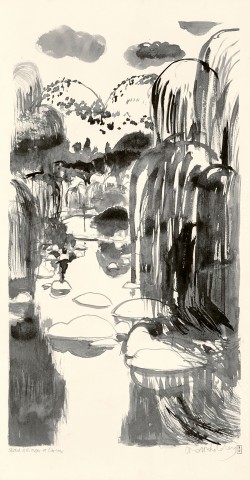SKETCH OF THE RIVER AT CARCOAR, c.1977
BRETT WHITELEY
ink on paper
96.0 x 50.0 cm (sight)
signed lower right: brett whiteley
bears artist’s studio stamp lower right
inscribed with title lower left: Sketch of the river at Carcoar
Robin Gibson Gallery, Sydney (label attached verso)
Private collection, acquired from the above in 1985
Christie’s, Melbourne, 2 – 3 May 2002, lot 11
The Cbus Collection of Australian Art, Melbourne, acquired from the above
162 Drawings: Brett Whiteley 1960 – 85, Robin Gibson Gallery, Sydney, 19 October – 6 November 1985, cat. 106 (as ‘The River at Carcoar, 1979’)
Last Acquisitions, Latrobe Regional Gallery, Victoria, 2 April – 10 July 2016
on long term loan to Newcastle Art Gallery, New South Wales, prior to 2006
on long term loan to Gippsland Art Gallery, Victoria
Nainby, B., Stanhope, Z., and Furlonger, K., The Cbus Collection of Australian Art, in association with Latrobe Regional Gallery, Melbourne, 2009, p.237
Sutherland, K., Brett Whiteley: Catalogue Raisonné, Schwartz Publishing, Melbourne, 2020, cat.99.77, vol. 3, p. 439 (illus.), vol. 7, p. 404
River at Carcoar (Autumn), 1977, oil on plywood, 203.0 x 121.9 cm, private collection, illus. in Sutherland, K., Brett Whiteley: Catalogue Raisonné, ibid., vol. 3, p.467
Small Preliminary brush drawing for ‘The River at Carcoar’, 1975, brush and ink on paper, 27.6 x 20.6 cm, Brett Whiteley Estate, illus. in Klepac, L., Brett Whiteley drawings, Beagle Press, Sydney, 2014
After a tumultuous decade abroad, in 1969 Whiteley returned to Australia and embarked upon an artistic pilgrimage to rediscover his homeland. Captivated afresh by the beauty, vastness and variety of the Australian landscape, he explored first the changing chromatic illusions and ‘optical ecstasy’ of Sydney Harbour’s Lavender Bay, before subsequently revisiting the landscape of his boyhood in the western New South Wales towns of Oberon, Kurrajong, Marulan, Carcoar and Bathurst. Indelibly embedded in his imagination, the gentle vales and hills of the countryside surrounding his school in Bathurst had been not only an important impetus for his precocious endeavours, but an endless source of solace and inspiration over the intervening years. Equally influential were the compositions of Lloyd Rees (see lot 29) which Whiteley had first admired at Macquarie Galleries one day after school – landscapes deeply poetic in their contemplation of soft curves and arabesques all rendered with impeccable tonality. As he later recalled in a letter to his artistic mentor, ‘…They contained nature and ideas, they contained naturalism but seemed also very invented, and the adventure of them was that they showed the decisions and revisions that had been made while they had been painted. I had never seen anything like that before… it set me on a path of discovery that I am still on today – namely that change of pace in a painting is where the poetry begins.’1
Painted around the same time as he was awarded the prestigious Wynne Prize for landscape painting twice in two consecutive years2, Sketch of the River at Carcoar, c.1977 offers a superb example of the pen and wash sketches, that Whiteley routinely completed – often en plein air – in preparation for many of his universally acclaimed pastoral paintings from this period, including Summer at Carcoar, 1977 (Newcastle Art Gallery) and Paddock – Late Afternoon, 1979 (private collection), painted at nearby Oberon. Like such masterpieces, the present similarly features the artist’s signature sinuous river meandering through the centre of the composition, flanked by burgeoning weeping willows and intermittent strewn granite boulders, with the sensuous, rounded curves of the mountains beyond. In his untiring efforts to depict this landscape in all its myriad seasons and moods, Whiteley recognised in such works a tendency which he described as ‘Chinese’ – not simply in his use of the calligraphic medium reminiscent of the Asian art he so admired, but more fundamentally perhaps, in the repetition of certain motifs to symbolise states of mind. The arabesques of rivers echoed the flight paths of birds, which in turn mirrored the artist’s relaxed journey through his own domain. As Sandra McGrath observed of the closely related oil painting, ‘The River at Carcoar borders on the surreal, having none of the convincing details to suggest that this is not a river of his own mental landscape.’3
1. Klepac, L., Lloyd Rees – Brett Whiteley: On the Road to Berry, Heide Museum of Modern Art, Melbourne, 1993, p. 7
2. Whiteley won the Wynne Prize for Landscape painting three times: in 1977 with The Jacaranda Tree (On Sydney Harbour); in 1978 with Summer at Carcoar; and in 1984 with The South Coast After Rain.
3. McGrath, S., Brett Whiteley, Bay Books, Sydney, 1979, p. 210
VERONICA ANGELATOS
